To procure an architect for its new Anthony Timberlands Center for Design and Materials Innovation, the Fay Jones School of Architecture and Design at the University of Arkansas, led by Dean Peter MacKeith, conducted an impressive competition process. (Its six shortlisted schemes are accessible in the competition report hosted on the school’s website.) In March 2020, as the world entered lockdown, a winner was announced: Grafton Architects, in partnership with modus studio. It was appropriate timing, as just weeks prior, Grafton’s cofounders Yvonne Farrell and Shelley McNamara were awarded the Pritzker Architecture Prize.
Arkansas is 57 percent forest, and its forest industry has an annual economic impact of over $5 billion, or about 4 percent of its GDP. The state’s trees create more biomass every year than can be used, which means the underharvested forests are becoming overgrown. As such, the timber and wood products industry is in search of new products for which its lumber can be used. In part, this task falls to educational entities to research and develop inventive ways to utilize wood. The proposed Anthony Timberlands Center stands to do just that.
“We seek a building that is redolent of the qualities of the forest, one that imagines anew timber and wood as materials. We seek a building that is hewn, carved, jointed, woven, and assembled, layered, laminated,” Dean Peter MacKeith wrote at the outset of this design process. The proposal from Grafton Architects appears to get close to this ambition. It masses a taller tower against the street, stages a lower shed at the rear, and unfurls a cascading sawtooth roof to connect the two elements, resulting in a dynamic section. Its appearance is skeletal and structural, but generous and warm, thanks in part to the biophilic qualities of wood. Inside, large wooden members define the open floor plate of the fabrication lab while structuring an auditorium and classrooms above. It’s a bit like a woody cover version of the interior of Giovanni Michelucci’s roadside San Giovanni Battista near Florence or a scaled-up take on Theo Jansen’s kinetic strandbeests. Either way, it manages to balance a sense of strength with an invitation to public life, a move that Grafton Architects has landed in other major educational commissions like their projects at Bocconi University in Milan or UTEC in Lima.
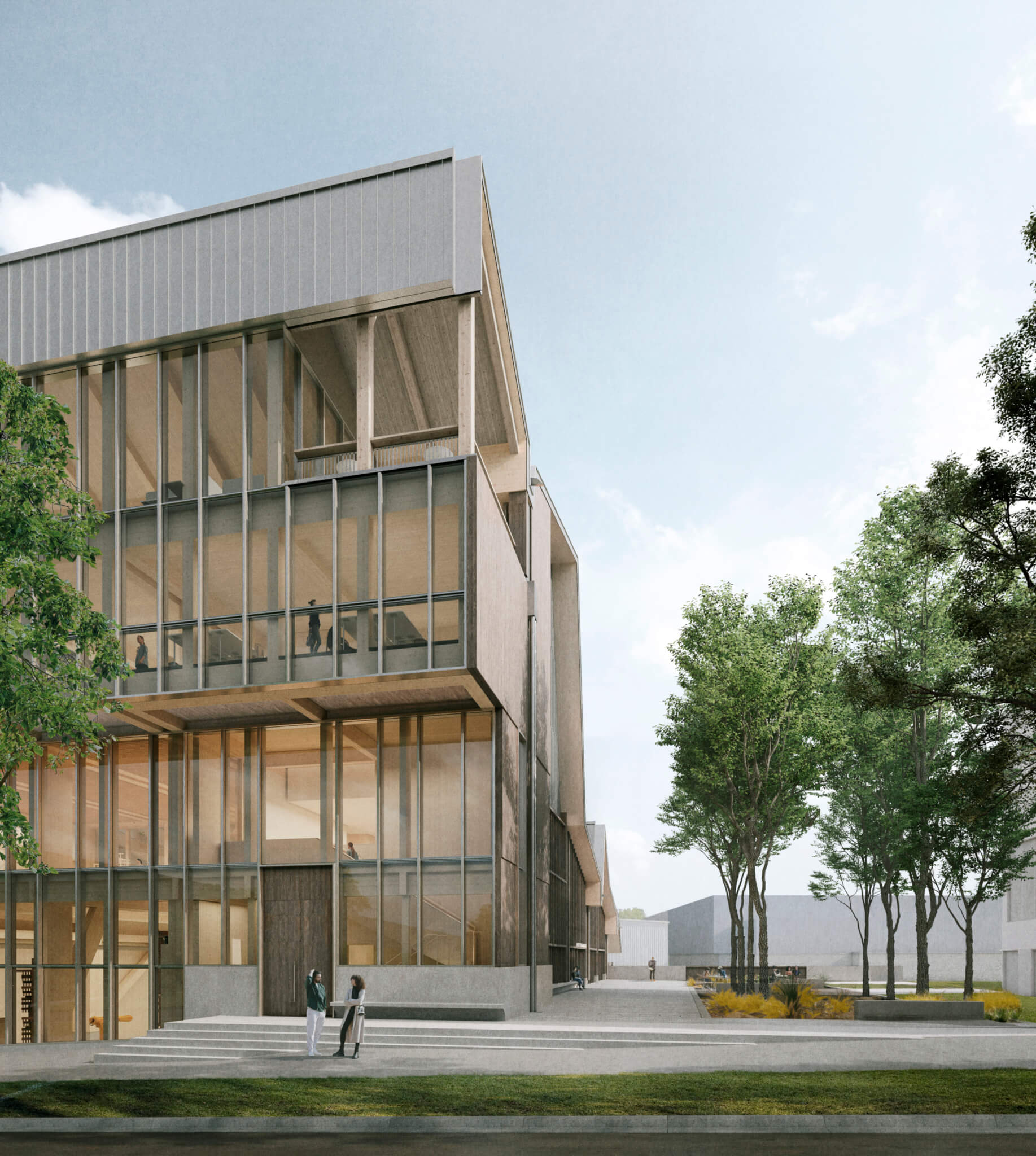
One juror’s assessment captured the architects’ urban intent: “Of all the proposals, this one presents the most compelling landscaping plan, demonstrating possibilities for integrating the architecture and art programs” in the growing Art and Design District, set just beyond a Cultural Arts Corridor that runs south from the university’s main campus. This satellite facility will host two other arts-related buildings: the Windgate Studio and Design Center designed by HGA and now under construction, and a third building to be designed by Tod Williams Billie Tsien Architects. Landscape architecture by Ground Control will knit the terrain together. MacKeith previously spearheaded the realization of the nearby 27,000-square-foot Library Annex Building in 2018, and in the following year, Adohi Hall, designed by Leers Weinzapfel Associates with modus studio, opened on the university’s main campus. Both were built using mass timber.
The Anthony Timberlands Center’s symphony of wood—heavy white oak members, glulam beams, cross-laminated timber panels, black locust facade, and cypress parts—attempts an encyclopedic arrangement of local species, with Southern yellow pine being the most prominent. These woods will be sourced from the state’s expansive forests. Like so much else during the past two and a half years, the building’s realization has been delayed. Originally anticipated to open at the end of this year, the project broke ground last year and is now expected to open in mid-2024. Costs have increased, causing the building to be edited and refined, a process that the architects say has made it better. Still, in less than two years, Grafton Architects’ alluring landmark will open on a corner opposite a Walmart neighborhood center. Given the latter’s investment in mass timber for its new office campus in nearby Bentonville, it’s not a bad pairing. While construction proceeds, the task is now to wait patiently for Grafton Architects’ first North American building to arrive.
AN’s managing editor, Jack Murphy, spoke with Yvonne Farrell and Shelley McNamara to learn more about the project and the work of their Dublin-based office.
The Architect’s Newspaper: Tell us about this impressive building you’ve designed for the University of Arkansas.
Yvonne Farrell: This project is fantastic because it’s both a building and a teaching tool. That’s what we were fascinated by. The competition was written in a way that the building would become one of the teachers of the wooden architecture. How do you do research about and gain experience with this material? The university is passionate about their students learning about timber, so there was a lot of dovetailing of interested parties to move forward towards a more sustainable future.
Shelley McNamara: The brief was practical but also very challenging. It wasn’t a cautious brief, as it requested a tall building from the point of view of the presence on the public thoroughfare but at the same time included a fabrication yard. We loved that challenge of going up for five or six stories in wood. There’s a big floor plate and then a vertical element, and we want students to enjoy being in one place. So we brought the dancing roof up over the teaching block. It has both a civic quality and this kind of casual, almost-no-architecture quality, which is something we enjoy about the project: It brings opposites—an academy with a fabrication facility—together. So many schools of architecture are becoming over-academic and removed from making, so the insert of making right into the middle of a university is one of the most progressive educational things that one can do. One of the most liberating things for students is to be able to use their hands and find the liberation of working physically with material, and here, in particular, with wood.
YF: Another amazing thing for us was the chance to work where Fay Jones previously made his own timber research, seen, for example, in his Thorncrown Chapel, which was made from standard wood elements. As practicing architects, we’re very conscious that we’re carrying the baton from previous generations. Here, it’s important that the structure is felt and isn’t wrapped in finishes. The auditorium is interesting because we wanted it to be hung between the big fabrication shop below and the teaching studios up above, so it spans over the big space. So by using a queen post truss, we’re using an element from the heroic, historic past to do a contemporary job, which is to help hang the auditorium slung between the fabrication shop and the city of Fayetteville.
Like our project for Bocconi University in Milan, one of the important spatial aspects for us is that our architecture engages with the general public. So here, outside on the sidewalk, members of the public can see through the windows to view the students at work. The building is a membrane between the student and the city.
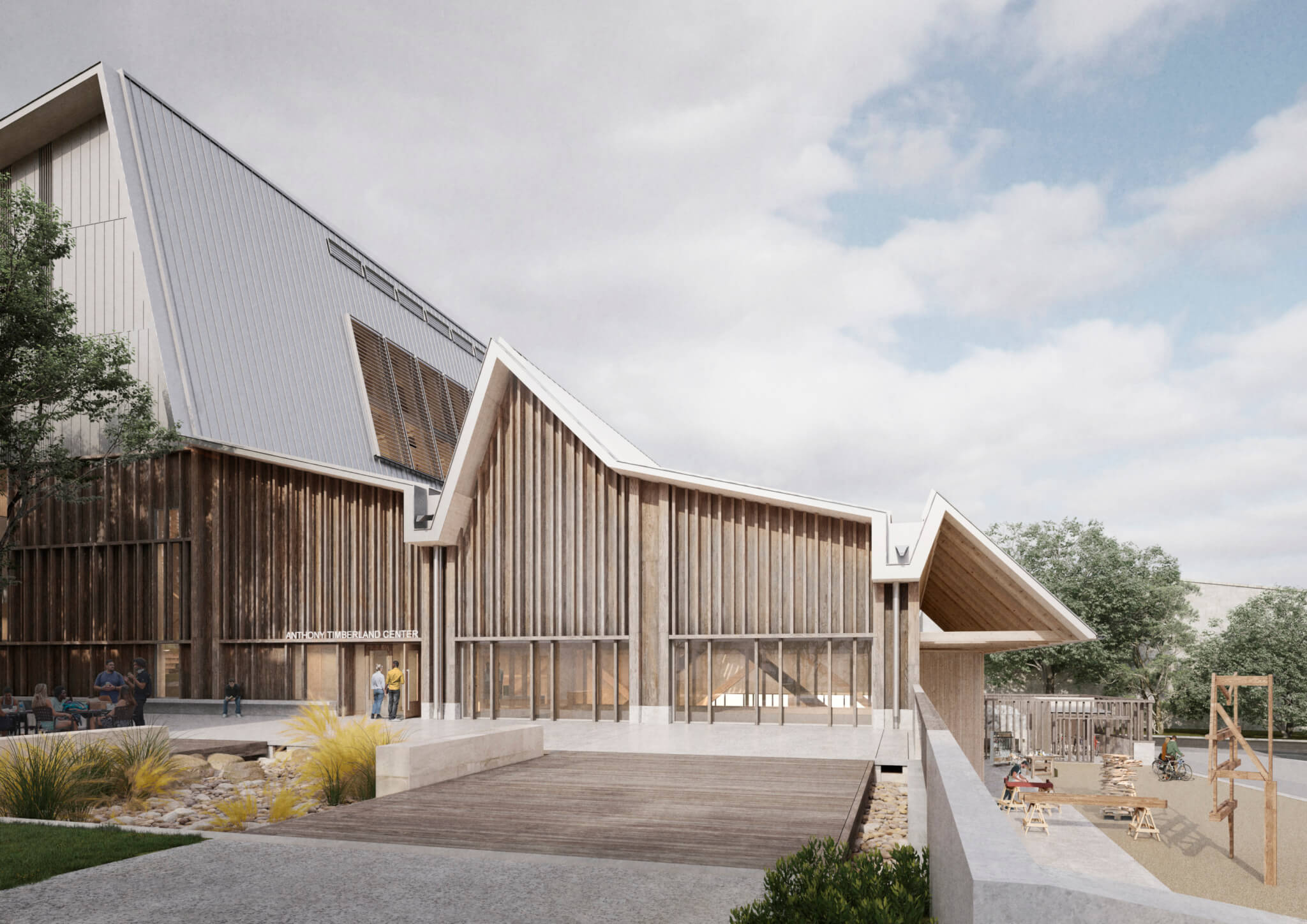
AN: The section of this project is striking, as there’s the articulation of the tower and then a roof that connects to the lower fabrication lab. What’s the power of the section for you? How is it deployed and articulated here?
SM: We try to think three-dimensionally. It relates to atmosphere, and how we try to stitch together fragments of space into an organizational construction. It also has to do with social overlap, especially in educational buildings, because students love to see something that isn’t always prescribed and formalized. It’s like in a city when you can accidentally perceive something that might amuse or inspire you. We did the same thing at Kingston University, where we brought dance, which is noisy, together with a library, which is quiet. It set up this amazing dynamic.
Architecture has the capacity to bring people together. A key role of architecture is to make places where people can happily come together and feel part of some bigger order, where you’re not an isolated individual but you’re part of some collective that you can engage with or retreat from. Section can resolve this.
Here, it was interesting to stretch a single-story roof vertically. At what point does it become really stretched? We like the section of Bagsvaerd Church by Jørn Utzon because of the way it comes up like a cloud. It’s a kind of crescendo. It’s not a new kind of volume for us, but it’s particularly nice in wood because it is a flexible, malleable material. By its nature, it can change direction. And in fact, that helps the structure, so it becomes a folded roof.
YF: Section is about setting up relationships, but there’s also an urbanistic aspect. The project is on a corner along a main artery within Fayetteville, so it is also staking out this satellite campus for the university. So it’s important that the project have a presence on MLK Jr. Boulevard, as when you pass in and out of the city, the building would register in your mind, not in an outlandish way, but in a way that states that it is a timber research facility.
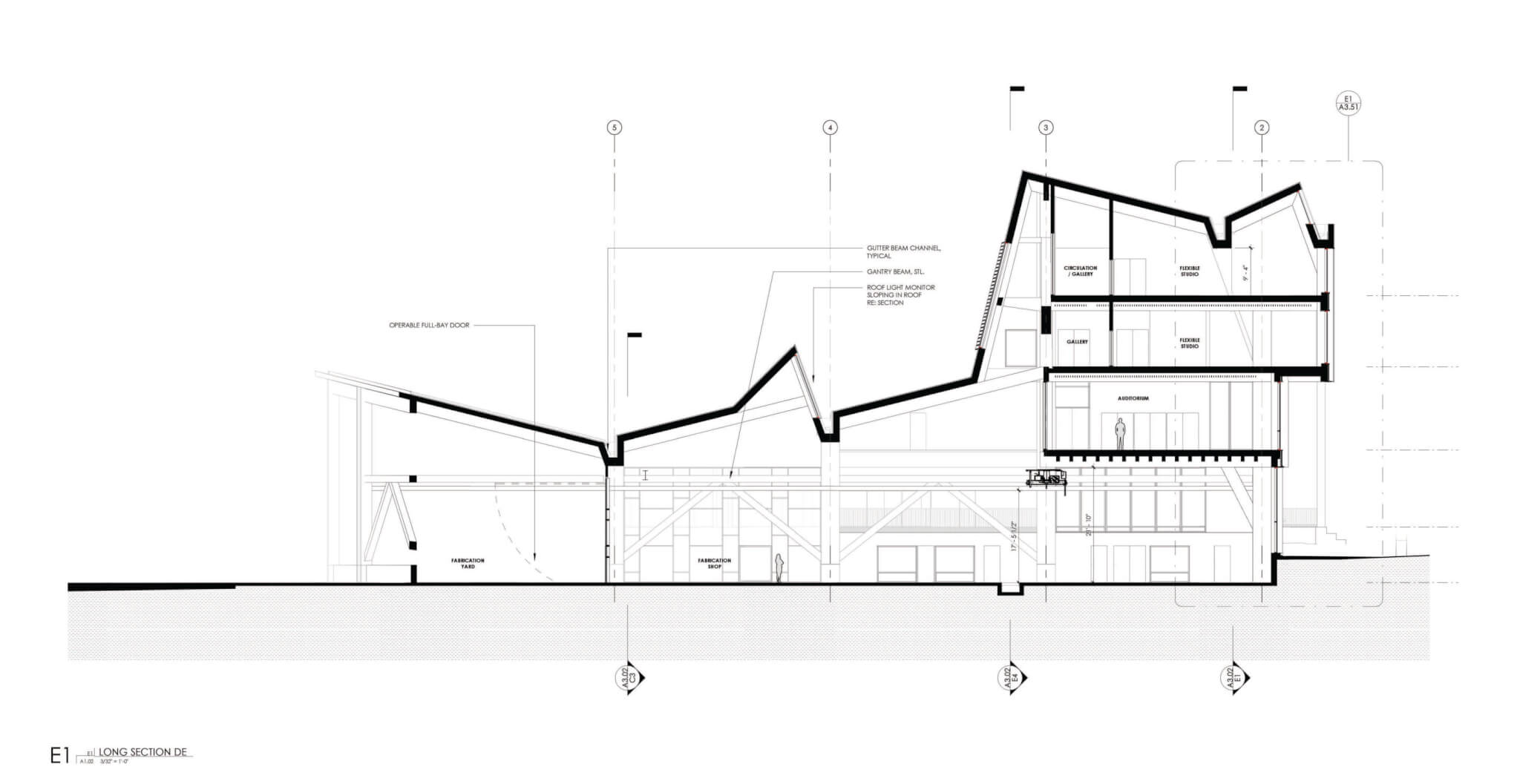
AN: I was really taken by the articulation in the roof, as it has a large gutter that makes a space that is clearly wide enough for a person to walk through and maintain. That valley is useful, but it also counters the floating upper edges of the roof.
SM: We’re quite used to rain in Ireland, but we worried about the rain in Arkansas. Because we had the room to play, we thought that the gutters should be generous and easily maintained. They also become part of the structure, as we have about a 50-foot span below, which is a long span for wood. These pieces become beams, and then we thought they could be U-shaped beams, which Yvonne calls “canoes.” We’re embracing the timber rather than worrying. If we’re making this roof, then we’re going to have water rushing into these gutters and because the building shouldn’t leak, then we should take advantage of this big span to do something pragmatic. That way, we build ordinary things into the architecture.
YF: What’s happening for us here in Europe due to climate change is that downpours are becoming more intense. When we were in college, you needed waterproofing upstands of 6 inches, whereas now you should have like 8 or 10 inches. We found a unique way to deal with water that serves as an architectural expression.
Then also there’s the big challenge inside in the fabrication room, which is when you look up, you see the underbelly of these things. These beams are like Atlas lifting up the world, so you see these elements doing their job on your behalf.
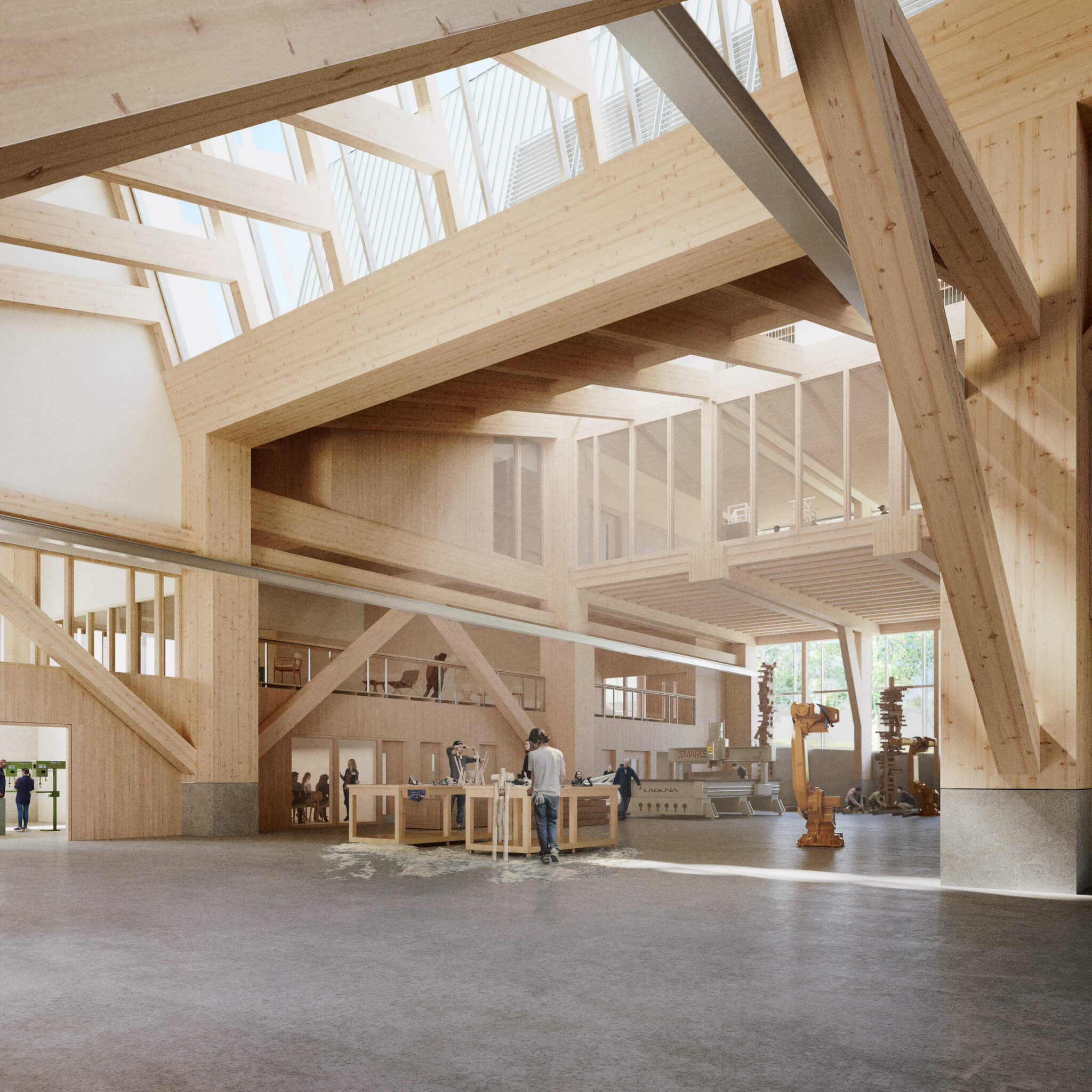
AN: The building is a storybook of timber. It really expresses, both structurally and on the exterior, the exploration of wood. How has it been designing with this material here versus in other building cultures? What would you say is distinctive about American timber?
SM: I would say that we’re frustrated timber lovers, as it’s hard to build in timber in Ireland and in the U.K. until recently due to regulations. We’re hoping it’s easier in France, where we recently won a competition. There are also significant hurdles to cross in the U.S. as well.
Regardless of what material we’re using, we try to use it with respect so that it maintains its dignity and that it doesn’t become sanitized by virtue of mass production. It shouldn’t become like another product, but that it retains some of its woodiness. That can be difficult, as sometimes wood just feels like plastic. We try to celebrate the integrity of the material; even if made into dust, it’s put together again into other materials. We’ve mixed several different uses. In particular, we love the queen post truss because it’s a big lump of oak. It’s an ancient construction element that was used in cathedrals. We’ve never used one before, but we’ve always loved them. It is fantastic here because it works to hang an auditorium above a fabrication shop. That’s something we’ve done before in concrete, but we’ve never hung an auditorium from a queen post truss. We’re trying to look at the industry for what it is and, at the same time, hold on to the integrity of the material so that in the end it does really feel like a timber building.
YF: The school will teach timber from the biggest spans down to the tactile interiors. Construction, at times, leaves craft behind. But we appreciate craft as something built by the hands of makers. It’s like an oral history, but it’s a physical history. If we can see this building as a piece of furniture or like a ship, then we think the timber industry has a chance to be both commercially successful and emotionally connective.
Buildings have inherent characters based on if they’re realized in timber, concrete, or steel. If you covered this all up, then you’ve lost the extra dimension that they can give at a human level. On the exterior, for example, we have black locust that will weather over time, giving it a patina. You have to love and maintain a timber building; it’s not like a Lamborghini that’s just washed down every so often; you have to take care of buildings and allow them to be themselves. They will respond to the wind, rain, sun, and orientation in different ways. People have to come to terms with that. Can you keep them almost pristine? Or is there a “shabby chic” that timber can become over time?
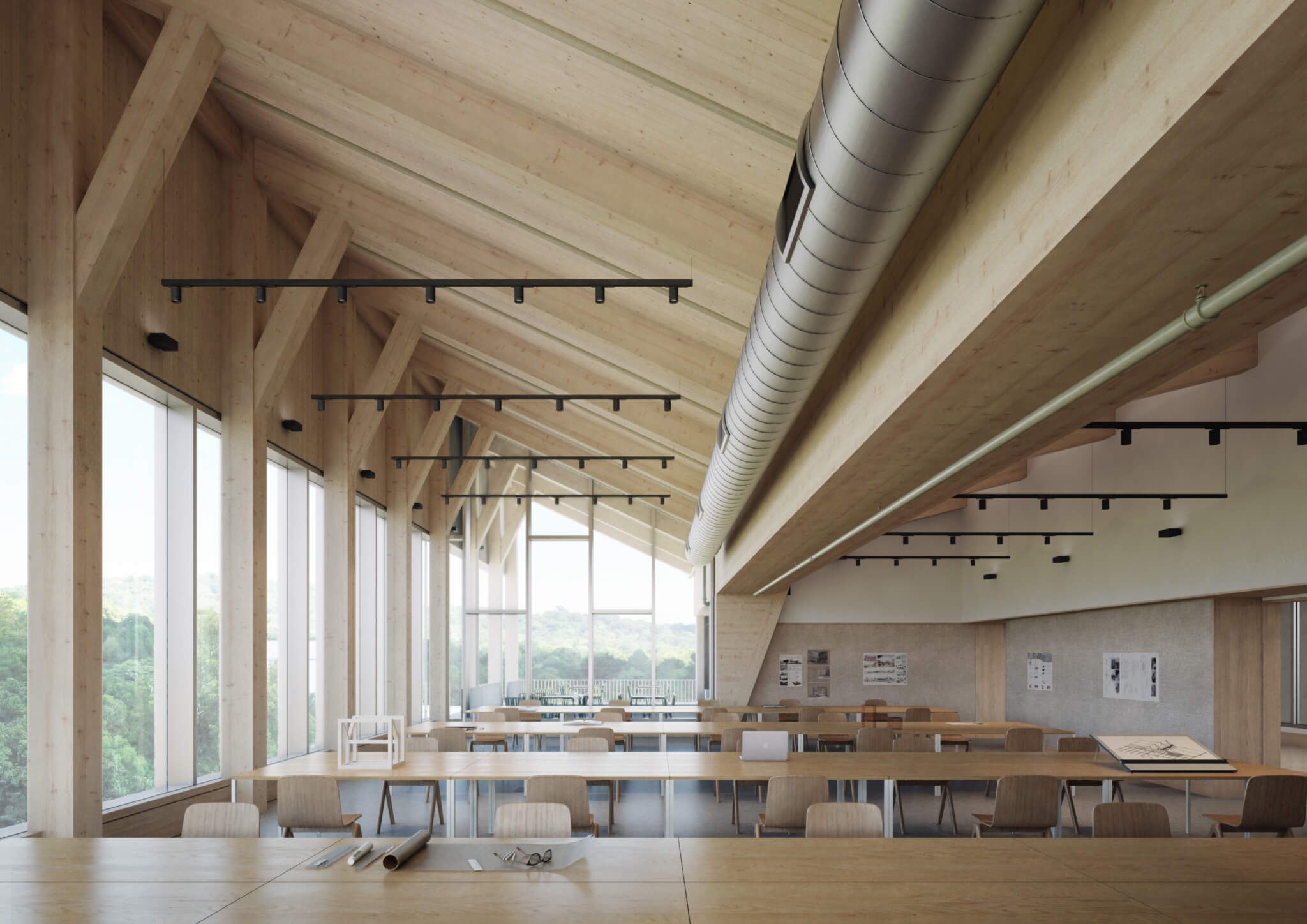
AN: As the project has gone on, there have been increases in the budget due to a variety of factors. Architects work through an idea and then carry it through the construction. Could you talk about how the ideas of buildings survive that process?
SM: I suppose we think about costs in the same way as the weather; there’s waiting, rain, snow, and there are costs. It’s just one of the things that architects have to deal with. I think that sometimes the distillation of a project means it gets better and closer to the core of things. Sometimes that’s not always the case; sometimes you lose things that take you years to emotionally recover from that sense of loss. But that hasn’t been the case in Arkansas. I think the project has become more and more refined. It’s like really good editing.
YF: It’s important for the school and the main donor that the essence of the project survives. It’s a bit like making a good sauce; it matures through the slalom of things that need to be done. You have to have a brilliant client, which is true of the University of Arkansas. They are passionate about this building as being a showcase project. All of the ingredients are here, and with modus studio, we have architectural teams on both sides of the Atlantic minding this project. It means a lot of responsibility, and we take the issues that arise seriously.
We edit where we have to, and we try to mind the architecture. None of the main ideas have been lost. I agree with Shelley that it’s become more refined. It’s never easy to push from concept to making, but that’s just what it takes. It’s not a piece of sculpture or a basket: This is a building for the city of Fayetteville, so we have to make sure it’s anchored, metaphysically and physically, so it does its job.
AN: Can you talk about the ground plane of the project? The lab is visible here, and outside there’s a plaza and presentation area. When I was looking at it and imagining it in use, it seems like a place where the city meets the academy, which made me think of the theme of your 2018 version of the Venice Architecture Biennale, FREESPACE. How are the ideas of that exhibition at work in this project?
SM: I think free space is something that we picked from what we have learned in practice. We feel that you always need to give back something to the city or to the landscape, something so that everyone benefits from a new project as much as the owner, let’s say. In Fayetteville, what was challenging with the street was that it’s an American boulevard, which has a faster pace and more of a relationship to the car. Still, we’re widening the pavement to open up the excitement of this progressive workshop because we think that citizens would walk by and see what’s happening. It’s the arrival of a new educational idea in town. We want to make this manifest in the experience from the street. The street slopes down, and the building comes out over it. There is a wall, but it’s not a hard wall— it’s generous. Things like the generosity of the sidewalk are so important in terms of needing to feel comfortable when people stand outside or when they leave after an event. The threshold is probably one of the biggest challenges in any project. How do you make that point of entry feel generous, welcoming, and civilizing?
The workshop is actually below the level of the pavement, so we took the opportunity to make a window where you can look down and see what’s happening. Our building at Bocconi University was similar: You look down into the foyer. You don’t feel you’re in a basement, you’re in the topography of the site and you’re enjoying sometimes being on grade and sometimes being below. It’s the same for citizens. I think it’s fair to say that FREESPACE came from experience: What else does this project do, apart from give what’s needed?
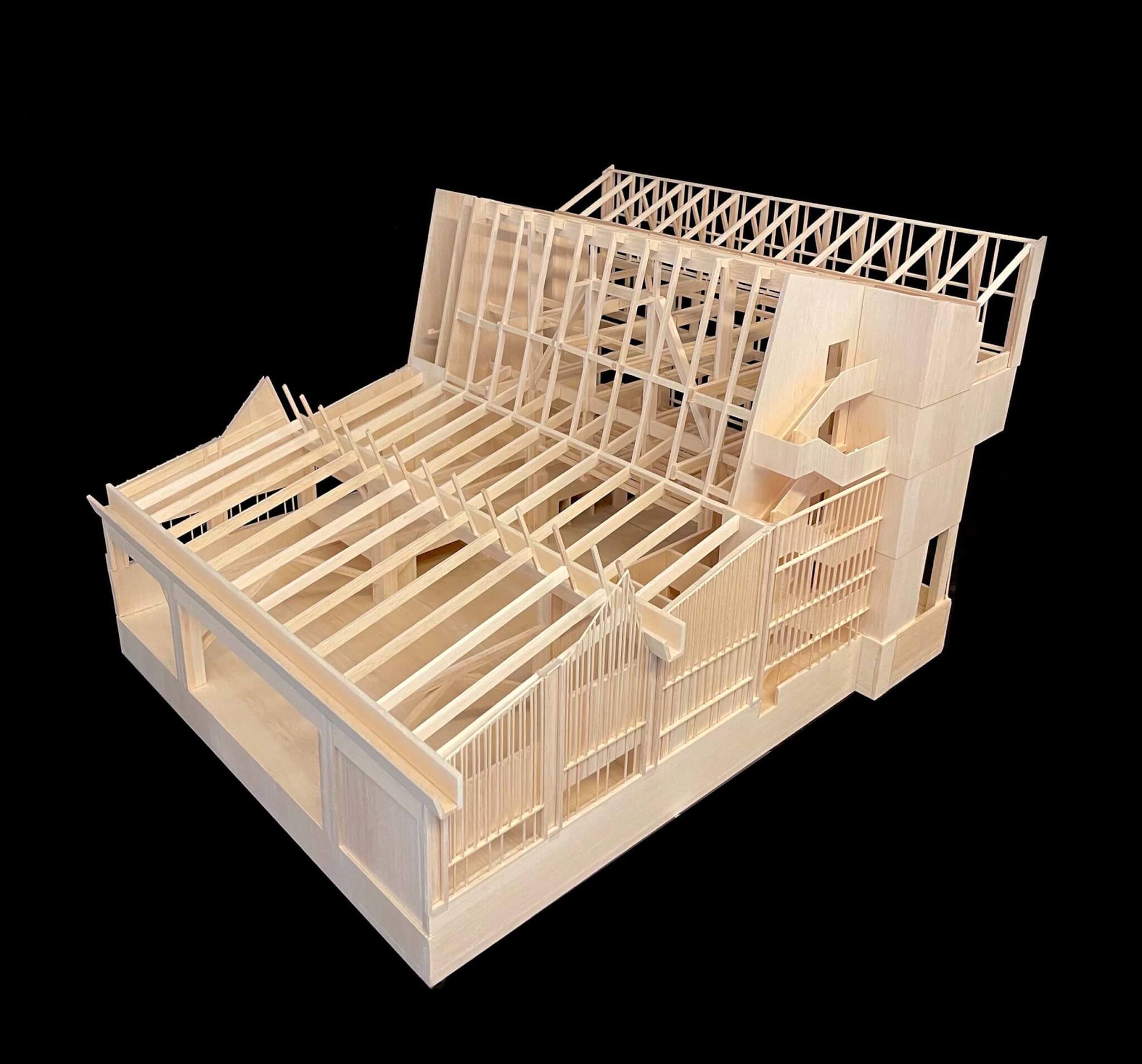
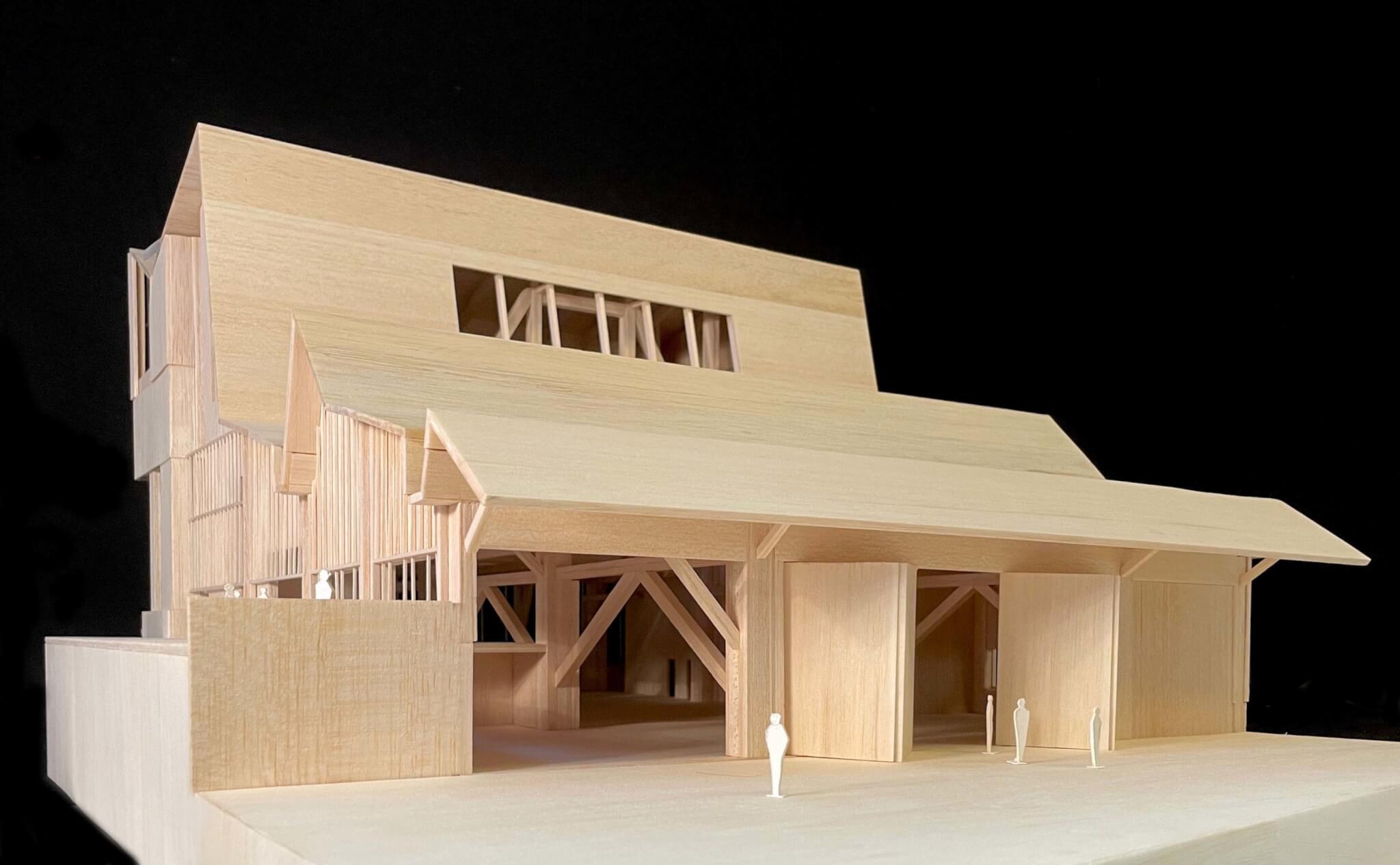
YF: Part of our manifesto was also that when you’re on a particular part of the earth, you are aware of that. From the two elevated outdoor terraces, students can look back to the mothership campus. They’re able to see that they’re a citizen of the earth as they stand out on the building’s prow, like a ship.
We also have the windows like Shelley described. Inside, when you’re up on the upper levels, you look down to the workshop, but you also look out and see the hills in the distance. In our FREESPACE manifesto, we wanted to talk about the free gifts of nature: You are aware of the rain, or you see the moonlight. Nature is around you, and you are aware that you’re not sealed in and held away, but that you can step outside. We’re making this lovely area called Anthony Way, named after the main donor, which will be an interstitial space for the next buildings on the campus. These areas are thresholds, and they’re thought about as “not-building,” but these are actually the things we’re designing. All of these spaces between the boulevard and the side road and the roads into the block have to be thought about architecturally. Architecture happens in the between; we’re interested in the in-between, in the ambiguous but considered. The covered yard will be a place where students make wonderful bits of timber transformed into something else, and then the art students will be a bit curious and come over, and then you never know what happens over time.
This article first appeared in AN‘s recently published 2022 Mass Timber digital issue. You can read the special issue, our fourth special Mass Timber issue to date, in full here.










